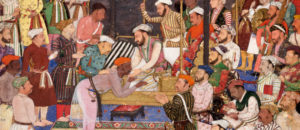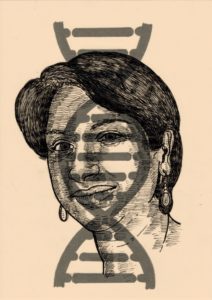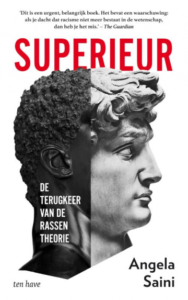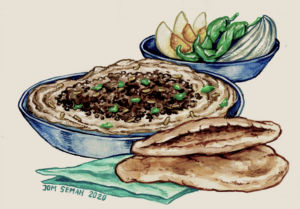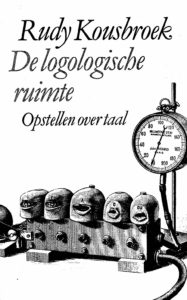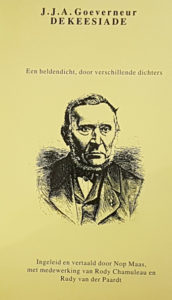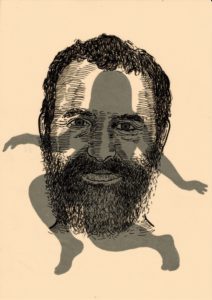Ardhakathanak: A Commoner’s Discovery Of The Mughal Milieu
Abstract
The Ardhakathanak by Banarasidas is often considered the first autobiography in Hindi. Completed in the year 1641, the book provides us with a commoner’s understanding of the Mughal world. Often subjected an imperial bias, the book is a wildly neglected source of history. The study attempts to highlight various societal norms and ethics as evidenced by the Ardhakathanak. It undertakes a thematic division in understanding medieval Indian society, focusing on merchant practices, societal norms and Jain religion. Various aspects of a middle class man’s life are unraveled through the course of this study, including education, business decisions, wealth, family, domesticity, religious assimilation, rationality and self-discovery.
The study also embarks on an analysis of the Varanasiya sect of Jain religion briefly. Finally, emerging trends of individuality are highlighted. The study culminates with a brief account of how underutilized this primary source remains despite obvious merits to it.
Keywords: Banarasidas, Ardhkathanak, autobiography, merchant practices, religious pursuits, cultural history.
1. Introduction
The development of the literary genre of autobiography is a fairly ancient one, with St. Augustine’s autobiographical work ‘Confessions’ written in 399 CE. However, the understanding of the term autobiography to be a form of ‘self life writing’ is a recent phenomenon. The Oxford English Dictionary credits Robert Southy to be the progenitor of autobiography in the year 1809. However we find a reference to autobiography or self-biography being used by William Taylor in the Monthly Review of 1797.[i]The motivations for committing one’s life to writing are often religious in nature, to record stages in an individual’s life by which they lose their own identity to celebrate God’s divine power.[ii] Today, these works have become a prominent source of history and are extensively researched to arrive at a deeper understanding of the period it was written in. The earliest known biographical work that was produced in India is the Harshacharita written by Banabhatta in the 7 th century CE. However, truly autobiographical accounts only appear in India with the advent of Mughals. Among these, Baburnama was the earliest, and records Babur’s life between 1483 to 1530.[iii] The autobiographies written during this period were meant to preserve a person’s family history and good deeds for posterity. Thus, the representation of the subject is in light of the reader’s judgement. Therefore, we may conclude that these writings often lack a humanizing touch that can relate the subject to the reader.
One such piece in the ocean of Mughal writings is Banarasidas’s Ardhakathanak. It was first discovered by Nagari Pracharini Sabha and published by Dr. Mataprasad Gupta in 1943.[iv]
Banarasidas was a Jain merchant who lived during the Mughal Era in India. The title of his autobiography translates to ‘half a tale’. The book was completed in the winter of 1641 in the imperial capital of Agra, when Banarasi was 55 years of age. In Jain philosophy, a full life is considered to be of one hundred and ten years. Thus, the title of Banarasi’s book ‘Half a Tale.’ Although, the tale began to be the story of half a life, Banarasi met his demise only two years after the completion of his book, implying that the story covered his entire life. Written in the language of the Indian heartland, Braj Bhasha. Ardhakathanak is considered to be the first autobiography in Hindi.[v] Much to the contrary to other Mughal works, Banarasidas’s tone throughout the book is that of unabashed candor. Over the course of the book, Banarasi establishes a rapport with the reader and slowly but surely becomes a friend. By the time, we reach Banarasi’s close of life, a feeling of a long and fruitful companionship lingers on with the reader. We know Banarasi’s secrets, sorrows and soaring moments. Unlike other autobiographical works of the contemporary period the emphasis is not on making a perfect man devoid of any flaws, fit to govern the territory of India, but to lay bare before the reader the heart and soul of subject, good or bad.
It is evident from the content of the book and style of writing that Banarasi did not expect his autobiography to be read nearly 400 years later. In fact, there was an understanding that it would only be read by limited audience of friends and kinsmen.[vi] In Banarasi’s own words, the only reason he ventured into the business of recording his life, is ‘let me tell you all my story’.
A Jain from the noble Shrimal family,
That prince among men, that man called Banarasi,
He thought to himself, let me tell my story to all [vii]
As is evident from the pretense set above, Banarasi’s account of his life was a commoner’s perspective of the Mughal Era. He was unconcerned with the political happenings of the Empire and did not occupy himself with it. But what was important to Banarasi, and thus what makes its way into his book are matters of business, religious practices, customs and the changing ideas that manifested into his own life. Although, Ardhakathanak can rival any other source of Mughal history in terms of the information it provides us. It does not supplement the information presented with quantifiable data, as is seen in works like Akbarnama. All the same, works like Ardhakathnaka can be monumental in filling the gaps between the ‘imperial-sanctioned’ view of history that is prevalent towards more subaltern approaches that weigh the subjects of the Empire directly into account. Furthermore, being an account that is written not for a political patron but oneself, it can overcome one of the major drawbacks associated with royal sanctioned works. Banarasidas represents not what others would want to see, but he saw himself, without fear of censure. It also becomes one of the few sources through which we can take the bottom-up approach of reconstructing history instead of the common top down approach. Ardhakathanak follows a chronological writing style beginning from a brief history up to the 55 th year of Banarasi’s life. Another interesting aspect of this account is that all events in his life are described along with the precise time of their occurrence helping us reconstruct a more organized form of Mughal history from a middle class merchant’s eyes.
2. Merchant Life in Northern India
Banarasidas’s Ardhakathanak is a major source for understanding mercantile practices and ethics in Northern India during the medieval period. Banarasi, right at the outset informs us that he is a Jain of the noble Shrimal family.[viii] Despite his Rajput lineage, the family took to a Bania life after conversion to Jainism. It was his grandfather Muldas, who first started a business.
Muldas Biholia, pursuing a bania’s way of life
became steward to a Mughal officer, and went away to Malwa [ix]
Businesses were usually dominated by the Hindu and Jain communities. In order to maintain this hegemony over the market, children were instilled with a sense of business tactics and ethics from an early age. It would not be wrong to assume that the kind of education being provided was tailored to meet future work requirements depending on the community one belonged to. Education began at the age of eight, and usually lasted for four years but could be completed earlier as well. Banarasi mentions that after his father completed his schooling, he could assess the quality of gold and silver, tell counterfeit coins from real ones and he could balance account books along with a basic understanding of Sanskrit language. Although, we can conclude that a higher premium was placed on practical learning as compared to theoretical knowledge. This becomes evident from the fact, that Kharagsen, Banarasi’s father, started a small business of his own as soon as he finished school.
When eight years old the boy became, he was sent to school.
At school he learnt quickly and soon became skilled at assaying gold and silver
He understood how to keep the books and write debits and credits correctly.
In his grandfather’s shop, he began learning the business of dealing in gold and silver.[x]
We also find information pertaining to the various kinds of markets that were in place. The general market was referred to as the bazaar. We also find evidence of other specialised markets such as mandis, where grains were sold; nakhsas, markets in Agra that sold goods including cotton and cattle; katras, enclosed markets usually found in large cities. Mentions of hats and and faris are also found. These were daily markets and were often places where children went to practice trade.[ix] Banarasi also goes as far as to provide us with the number of sarais, bazars and mandis in Jaunpur to be 52. Furthermore, storage hubs were available, where one could store goods at the payment of a fee.
Within the city were fifty-two sarais; Fifty-two parganas surrounded it.
In the city were fifty-two marketplaces, And fifty-two great mandis. [xii]
We also find mentions of 36 pauni or shudra subcaste that offered their services in the markets. However, contemporaries like Abd ur-Rahim Khankhanan mention even more in his poem ‘Nagar Shobha.’[xiii] Here one observation must be made, the prevalence of various markets in a single city necessitates a huge number of shopkeepers, traders and moneylenders within the market for its upkeep. One possible reason to explain this can be the meagre amount of capital required to open a business owing to the cheapness of goods. We find evidence of Banarasi restarting his business with two hundred rupees only.
Her mother replied, ‘don’t lose heart, I have two hundred rupees
Which I shall give you in secret, so that he can go back to Agra’. [xiv]
We find detailed information about the business of jewellers from Banarasi’s account. The lure of business probably stemmed from the fact that one could make huge profits in this business. The items traded included rajat (silver), sauvann (gold), hira (diamond), lal (ruby), moti (pearl), manik, chuni and mani (precious stones).[xv] During the time, there was a common tendency to hoard wealth in underground safes. In extension to this, men in businesses did not disclose how much wealth they possessed. Frugality was considered an important trait for businesses, and money was only spent on lavish affairs like marriages.[xvi]
From the above account we can assume that trade was flourishing during the seventeenth century. Moreover, it was a profitable business. Thus, it is certain that various rules and regulations would have been put into place to ensure the proper functioning of the markets. Loan facility with interest was available as is evidenced by the presence of moneylenders. However, the repayment was usually manifold times the principal amount, not due to extortion by the moneylenders but out of obligation for lending under dire circumstances.[xvii]
We also find evidence of partnerships being entered into for business purposes. Although partnerships were more prevalent within the same caste, those outside were not prohibited either. Kharagsen also entered into a partnership with Muldas, an Agarwal, in his early days in Jaunpur.
Ramdas, a wealthy bania, an Agrawal of good temper,
Had entered into partnership with Kharagsen, looking upon him as a friend.
It was a union based on affection, trust and understanding [xviii]
The partnership was a highly organised form of business. Both the partners had equal share in the profits and losses, and proper accounts for all transactions were maintained. Furthermore, both partners had one copy of the accounts. The dissolution of the partnership could only be initiated when both the partners were present and in agreement. All prior credits and loans had to be paid off before dissolution. We also find evidence of a mediator to find solution to disputes.
It was Samvat 1670, when the necessary paperwork was completed.
Banarasi parted with Dharamdas and ended their partnership. [xix]
All decisions regarding the business practices and well being of the community were taken by a council. This council can be dubbed as the ‘business council’. It consisted of representatives belonging to a particular trade. They conferred among themselves and decided upon plans of action whenever an adversity befell them. For instance, when Nawab Qilich flogged all the jewellers in Jaunpur, the council decided to leave the town.
Upon returning, they conferred among themselves and decided to run away,
Taking with them their personal belongings, after all who would walk into the jaws of death? [xx]
Finally, one of the most important unwritten rules of the Banias was their secrecy. A bania would never divulge his business secrets to anyone lest they take advantage of this. This also becomes evident from Banarasi’s account of the nine subjects that must not be talked about including age, wealth, affairs of the household, deeds of charity, glory, infamy, measures taken for health, escapades and plans for future.
He established a successful business, this is a secret matter which must not be told.
One’s age, income and household matters, acts of charity, honour and dishonour,
the medicines one takes, sexual escapades and future plans,
are nine matters that must not be revealed. [xxi]
The merchants of Northern India belonged to a distinct section of commoners in the Mughal society and often possessed large quantities of wealth. This, in turn, threatened the power dynamics of the Mughal countryside. Suffice to say, Mughal administrators often tried to establish their control over the merchants and extorted money out of them. One instance where this becomes increasingly evident is when Qilich Khan, the city’s governor, put all the jewellers of the town in jail and demanded a huge amount from them. When the jewellers refused, he flogged them with thorny whips till they were dead.
One day he arrested all jewellers and threw them in prisons.
He asked for huge amounts of wealth, that the jewellers did not have.
He chained them and lined them up like thieves,
And flogged them with thorny whipped till they almost died. [xxii]
Roads were infested with robbers and dacoits. Valuable material often had to be carried hidden in underwear or around waistband. Merchants sometimes also made use of disguise to fool robbers. Other problems also included weather inclements and overcrowded inns.[xxiii]
Customs, Traditions and Changing Notions
The social settings as highlighted in Ardhakathanak are distinct from any other source that we come across during this period. The merit of Ardhakathanak being that it is a householder’s account, and we are able to witness customs and practices at the grassroot level. In the early medieval period, occupation based groups had crystallized and caste lines were becoming more fluid among the business communities. However, caste continued to play an important role in the life of a commoner. The importance of this hierarchised division can also be inferred from Banarasi’s account. Like we saw earlier, Banarasidas was a Jain Shrimal, he firmly establishes himself to be of Rajput descent. Although Rajputs were Kshatriyas and were prescribed to indulge in administrative or war activities, Banarasi’s family had a jewellery business. Two explanations can be offered for this, either the author lied about his ancestry which was prevalent among lower castes to elevate their status[xxiv] or since his family were converts to Jainism, and the precepts of Jainism prohibited harm to any living creature they couldn’t practice agriculture or indulge in war.[xxv] Other instances that hints towards the rigidity of caste is the insistence of Banarasi’s family on giving up learning. They believed it to be the profession of a poor Brahmans.
Learning is meant for brahmins and bards, The sons of merchants sit in the marketplace.
Those who spend all their time in learning go hungry. Listen, son, to what your elders tell you.[xxvi]
Despite these admonitions from his family, Banarasi continues to pursue learning. Later he achieves the true goal of his life and also authors numerous books. From this account, we can infer that it was possible to change one’s profession irrespective of class. However, we must also note that Banarasi was already a Kshatriya who pursued a Brahman’s profession. This can indicate that mobility was mostly possible only for the privileged castes. Furthermore, one could only jump from one rung to the next.
Another important social aspect of middle class life that we witness is the importance of family in one’s private and public life. The family dynamics make an important part of Banarasidas’s book. Familial obligation makes its way into Banarasi’s account in many instances. One example of the same is when Kharagsen’s father died, he and his mother were evicted from their house. So, they made their way to the house of Madan Singh, Kharagsen’s maternal grandfather. Madan Singh accepted them as their own daughter and son, he also provided them with immense riches and comfort.
Daughter, think of it no more. Joy and sorrow are as transient like shadows.
He embraced them and gave them fine clothes and jewels to wear.
They lived in peace and contentment, unaffected by the passage of time.
Three years went by in this manner, in harmony, in affection, happiness and peace. [xxvii]
We find another instance where familial obligation had to be met. Here Kharagsen entered into a partnership with Sundardas, after he and his wife died. Kharagsen took it upon himself to get his daughter married in a grand fashion. This was perhaps a show of gratitude towards Sundardas for being a fatherly figure.
Sundardas’s daughter was unmarried, Kharagsen got her married with great ceremony.
He have her both honour and gifts, golds and riches too. [xxviii]
We also find evidence of involvement of the elders in the personal matters of family members. They often act as a moral compass and advise the members on the desired course of action. This also hints at how important the family is in a householder’s life. Further, we can also infer that the family, including distant relatives, functioned as a single social unit.
Banarasi returned to Jaunpur city. The members of his family sat him down
And the elders lectured him on the error of his ways. [xxix]
From the above, it is evident that a huge premium was placed on family life. Thus, the age of marriage for both men and women was quite low. We come across a reference to Banarasi getting married at the age of nine, for women this age might have been even lesser.
Meanwhile, Banarasi turned nine years of age.
In the town of Khairabad, lived Tambi Parbat and his son Kalyanmal,
Who had one daughter.
He married Banarasi with her, with a tilak on his forehead. [xxx]
Domesticity is an essential pillar in any householder’s life. Thus, it becomes a topic of prime concern in our understanding of Ardhakathanak. Provided that feminist studies are trying to recover the role of women in public spheres, it is also equally important to recover role of men in emotional intimate spheres that are denied to men in a patriarchal structure.[xxxi] Although, Banarasi was married thrice in his lifetime, his account is strikingly quiet about his wives. The only description we get is of Banarasi’s first wife, when she provides him with emotional support after a business failure. One possible reason for this quietude, it the notion that personal matters must only be discussed outside the public sphere at night. Within the patriarchal framework, men are often denied the pleasure of expression. They are seen as unemotional and rational, standing in stark contrast to traits attached to females. Throughout the story, we do come across instances when Banarasi has indulged in emotional excesses upon hearing news. One such instance is when Banarasi hears the news of the death of his son and wife, and his engagement to his wife’s sister in one go. We see Banarasi overcome with grief and a sense of happiness, unable to process this emotion, he breaks into a crying fit with his friend Narottamdas.
She had given birth to a third son, and attained both happiness and sorrow.
Fifteen days after his birth, mother and son both died.
Banarasi’s wife had a sister, to her a marriage proposal was then sent,
Kharagsen accepted this proposal at an auspicious hour. Reading both the news together,
Banarasi and his friend fell into a crying a fit,
and with much effort he pulled himself together. [xxxii]
Finally, we will look at the portrayal of women in Banarasi’s account and analyse the spaces that were made available to women. The very first observation that we must make, is that men continued to have control over women even in the realm of domestic decision making. Here we must note, the gendered division of spaces where women are limited to the domestic household and men have access to public spaces. This becomes evident from one instance when Banarasi was seeking shelter during rain. A woman offered him a place to rest, however her husband admonished her and threw Banarasi out.
It was a dark night, in the winter month of Agahan.
A woman offered him shelter, but her husband picked up a stout stick. [xxxiii]
Although the general condition of women was that of meek subjects, we find instances when they appear as formidable characters in the story. This can hint towards a possible change in currents and upward mobility in the status of women. One such instance is that of Banarasi’s grandmother who makes her way to maternal house bereft of a husband and all her wealth. This also stands in stark contrast to the general outlook of women being seen as weak and easily overcome by emotion.
For the home of Madan Singh, jeweller, Kharagsen and his mother searched, asking people for directions,
Till at last, Destiny determined by their karma, Brought them to his house. [xxxiv]
The movement from domain of erotic love to the comforts of family life was of course available to men and not to women.[xxxv] This is evident from the fact that Banarasi after having an extra-marital affair could still go back to his wife. That being said, we must not
mistake this to be a situation where the wife had no control. In the same instance, Banarasi’s in laws refused to send their daughter back with Banarasi on account of his affair. Thus, we cannot perceive women to be powerless figures within the household. In addition, it can also be concluded that extra-marital affairs were not perceived in a positive light within the society. As we pointed out earlier, Banarasi’s elders admonished him and suggested he go fetch his wife from her home.
Banarasi went to Jaunpur, to get his wife back.
But her parents refused to send her back.
Banarasi then fell on his father’s feet and cried,
His mother beat her chest seeing her son so distressed.
Kharagsen, ashamed of his son, called him many names.
Banarasi wept and wept, he could not say a word. [xxxvi]
Women also had access to personal wealth and property. They could even undertake small business ventures. We find reference to Banarasi’s wife lending him 200 rupees to restart his business. Furthermore, upon Sundardas’s death, his daughter inherited all his wealth. These instances hint at economic involvement of women at some level, alternatively it could also mean that women handled finances within the household and had a degree of authority over how it was used.
For Sunadardas’s property, he followed the ruling of the panchayat.
He gave everything to his sister, keeping nothing for himself. [xxxvii]
4. Religiosity and Rationale
Throughout Banarasidas’s account we find examples of religious expression. Suffice to say, religious identity was an essential part of one’s being and played an important role in determining the lifestyle of a person. This is evident from Banarasi’s identification of himself as a Jain, devotee of Parshav and Suparshav at the very beginning.[xxxviii] This can also be indicative of a progressive religious policy that was enacted by the Mughals, particularly Akbar. The fact that the emperor did not segregate the people into ‘true’ and ‘false’ believers of God and accepted all religions as valid pathways to God, was bound to please the Jain community. This mutual respect is also visible in Banarasi’s account of Akbar’s death when the entire city was in a state of mourning. We also come across certain tenets of Jain philosophy such as the conception of death as the ultimate end for everyone who existed in the material realm[xxxix], the presence of multiple realities that one achieves after death [xl], eight virtues of a Jain [xli] and the philosophy of relativity of reality i.e. the non- absolute nature of existence.[xlii] Another peculiar teaching we come across in this aspect is the vow that Rai Dhanna took to never build a house, despite being a rich diwan in Bengal.
He practised the Jain rites of prosadh and pratikraman
And had taken a vow never to build a new house. [xliii]
Here we must consider how religious teachings may have had an impact on how business was conducted. There is a general understanding that religious tenets impinged on trade, however it is a wise merchant who refrains from building a house.[xliv] From the above instance we can suggest that Jain teachings had evolved over time to include the virtue of frugality, provided that much of the Jain community indulged in business activities. This can also be corroborated from the eight virtues of a Jain that include abstinence from alcohol, honey, meat, the five forbidden fruits and not eating after dark among others.
Banarasi’s account of Jain practices becomes even more important to us when we place it in historical context of the growing influence of Hinduism. This process has often been referred to as the ‘Hinduisation’ of Jainism.[xlv] We find many instances that suggest Banarasi was caught in the middle of this process. We find recurring mentions of pilgrimages to holy sites that were likely organised by affluent men.[xlvi] Furthermore, we also find instances of fasts, vows and applying of teeka (vermillion) before a journey which are predominantly Hindu concepts. Another instance in this regard is the worship of Sati Aut and Lakshmi. Banarasidas’s family prior to Banarasi’s birth visited the temple of Sati Aut, hoping for a son. A similar trip was made after his birth, asking for a long life for Banarasi. The myth of Sati, as a virtuous wife, who sacrificed herself at her husband’s insult can be found in Puranic Hindu traditions. Additionally, we also come across instances of Lakshmi being worshipped before starting a business venture in the account.[xlvii] Although, Jainism does not have a concept of caste based division, we see that every character mentioned in Banarasi’s account is introduced as a member of a particular caste. Thus, it is evident that caste-based identities had gained traction even within the Jain fold. Perhaps, the best depiction of this process is visible in a pilgrimage Banarasidas himself undertook, where he first took a dip in the Ganga and then offered his prayers to Parshav and Suparshav in a temple. This instance is extremely telling, as we can actively witness the process of assimilation.
Upon reaching Kashi, he first took a dip in Ganga.
Then he worshipped Parshav and Suparshav, with devotion in his heart. [xlviii]
It is evident then, that a process of Hinduisation was active during the 17th century. This was bound to produce a certain degree of discontent among the practicing Jains like Banarasi. Banarasidas’s account is an illuminating account of a person’s discovery of self through religion. It is brought to our notice that Banarasi was a Jain Shwetambar, however through the course of his journey he has a stint with Shiv Bhakti before finally returning to the Jain fold again. We find many instances that underline this brewing discontent within the protagonist. The very first time that we encounter a dissatisfied Banarasi is after a sanyasi cons him, distraught about his own gullibility Banarasi seeks the help of Bhanchand, his religious guru. Bhanchand explains to Banarasi that such godmen and their tricks are false and illusory, and one must not get occupied with them. This is perhaps the beginning of Banarasi’s quest for the ultimate truth.
He told Bhanchand of his dilemma. When Bhanchand explained that-
such matters are false and illusory, Banarasi realized the truth.[xlix]
We find many such instances that indicate towards Banarasi’s saturation with religion as he knew it. This is evident in the way various rituals are described in the text. At one point after Banarasi offers prayers to Shiva by blowing a conch shell, he describes himself as a shell too. Here, he implies the superfluous nature of such ritualistic worship.
Shivdev in the form of a shell, And the great shell Banarasi,
Both came together, The Lord and his servant, alike. [l]
Yet another instance highlights Banarasi’s conception of worship to be transactional in nature, where worship is only offered in expectations of a reward. Additionally, various fasts and vows are observed as penance for having strayed away from the Jain path to God. After the conclusion of Banarasi’s short period of Hindu worship, he decided to give up all his vices and observed the fourteen vows of Jainism and offered prayers twice every day.[li]
Finally, we can see the story coming to an obvious conclusion with Banarasi discovering Adhyatma through Arathmal Dhor. We can find a change in Banarasi’s understanding of religion. He says that he no longer believed in rites and rituals, and scorned image worship.
He also gave up his clothes. This is also highlighted at the end of Banarasi’s account where he identifies himself as Banarasidas who is an Adhyatmi and a contended man, as opposed to the beginning of his text where he calls himself a worshipper of Parshav and Suparshav.
Residing in Agra. A Shrimal of the Jain faith,
Banarasi Biholia Is an Adhyatmi, and a contented man. [lii]
During this time, he wrote various treatises such as the Gyan Pacchissi, Dhyan Battissi and a translation of the Samaysar Natika. It was during period that he fully understood the meaning of worship. He soon became a prominent figure among the Adhyatmis. In fact, we find mentions of a sub sect called the ‘Banarasiyas’ or the ‘Varanasiyas’[liii], who were followers of Banarasi. His doctrine involved questioning one’s faith to come to terms with it and giving up all forms of ritualistic worship. It was a general understanding that the relationship between a devotee and God cannot be mediated and a true devotee achieved fulfilment by himself. The sect was popular among both Shvetambars and Digambars (two schools of Jainism), however the radical nature of this doctrine attracted a lot of opposition. Meghavijay’s Yuktiprabodh begins with a critique of the Varanasiyas accusing them of being heretics.[liv] He believed that the Varanasiyas did not even stay true to their Digambar scriptures. The Samaysar Natika, however, also acts as a compilation of Banarasi’s ideas and views on worship. This text underlines Banarasi’s doctrine of self-fulfilment distinct from Digambar scriptures. Thus, we can classify the Varanasiyas as Neo-Digambarites. Despite the presence of such a rich body of literature, the Varanasiyas did not survive for long after Banarasi’s death and the movement only gained traction in the 17th century.
Here we can witness a pattern emerging in terms of religious reformations. The medieval period is replete with instances of movements that aim to purify religions of official intervention by the priestly class. We can cite examples of the Reformation in Europe, that was triggered by priestly excesses, or the Bhakti Movement in early medieval India. We can argue that a general understanding was reached during this period that one’s religion is private and should remain outside the ambit of regulation. A greater emphasis was also placed on inclusion of sections of society that were earlier prohibited from access to certain religions by anchoring new doctrines around self-effort. This hints at a broader historical process that had its roots in the socio-cultural and economic underpinnings of the medieval world. Although, the reformers also wanted to cleanse the religions and revert them to their classical forms, the real meaning of these changes was to adjust the religions to the reality of the medieval world.[lv]
5. Conclusion
The Ardhakathanak upon first reading may not appear to be a very intriguing tale. However, as we delve deeper into the world presented to us through Banrasi’s writing, we encounter many complexities of human nature and society. At the outset, it looks like a story of a simple man, but it is indeed an account of a devotee’s religious pursuit. Here, we should look back to one of the first premises we established, the purpose of writing an autobiography is often religious. Perhaps the most remarkable aspect of this text is its astonishing ability to collapse the centuries, and to make 17th-century experiences seem not merely vivid but also entirely understandable to the reader of today. If the Ardhakathanak is a unique witness to a particular time in the history of India and the world, it is equally a remarkable statement about the timelessness of human experience, as felt in such moments as the cloying taste of remorse, the beauty and strength of friendship, the frustrating difficulty of making one’s way in life, and the unbearable—yet somehow borne—tragedy of parental bereavement.[lvi]
We also come across the development of ‘individuality’ as a trait. This is evidenced from the numerous autobiographies that are produced during this period. We find an emphasis on the ‘cult of individual’, that is commonplace today. This particular cult of individual, however, is not based on a seemingly exalted definition of a perfect man but it hinges on being relatable. This is evidenced by a list that Banarasi presents at the close of his book. He highlights his vices and virtues as they were when he completed the book, diminishing the concept of an ideal human. The development of such autobiographical texts marks the coming of modernity to the Indian subcontinent. A similar trend is also seen in religious reformation that hinged on individuality and private worship. Thus, Banarasi’s life story illustrates important changes in medieval Indian society and culture, of which the most important were a growing interest in personality, in the development of individual aspects of literature and culture, and the individualisation of creative activities and culture itself. We can infer Banarasi too had a hint of vanity to be able to present his story to the world. The Indian novel has always had a symbiotic relationship with its own modernity. They are reflections of the environments that they are produced in and the social relations that the protagonist has with the world.
It is abundantly clear at this stage that Banarasidas’s Ardhakathanak holds a mirror to the backdrop that it is situated in. We have also established the validity of the source for understanding the Mughal milieu by providing glimpses into the socio-cultural and economic context of that time. The text describes these situations not as a stranger, but someone who is very well situated within them. Thus, we can suggest that the information that does comes across in the text is a peek into the insider’s world. This peek is free of bias and elucidates in a manner that is true to the core. The instances we find where Banarasi refuses to divulge certain information can also be explained, when Banarasi wrote the Ardhakathanak, he knew that it would be read by his friends and associates, people he came into contact with daily. Revealing the secrets of his business success or confessing to the details of an indiscreet or unwise act, may not, in such circumstances, have been the wisest thing to do.[lvii]
The text can be an extremely rich source not only for historiographical contributions, but also in the field of literature and the arts. Despite this, Ardhakathanak remains an extremely under-utilised source. In fact, Dr. RC Sharma dubs it to be a ‘neglected source of Mughal history’. We can thus conclude, that an entire body of research can be conducted on Banarasi’s life along with the supplementary literature that he produced in his life such as the Samaysar Natika to unveil further intricacies of the Adhyatmi lifestyle in the medieval period along with the development of Hindi literature and its interaction with Persian cultures. Banarasidas too leaves us with a similar remark. At this juncture, I am obliged to caution, we are all now a part of Banarasi’s cult of individual.
He has told us his entire tale in the doha and chaupai metres, In six hundred and seventy-five stanzas.
Those who recite it, hear it, read it, To them, his good wishes. [lviii]
References
[i] Kendall, Paul Murray. 1967. Encyclopedia Britannica: Volume II. p. 856
[ii] Saikia, Arani. Society as Reflected in the Assamese Life Writings of Nineteenth Twentieth Centuries 1834-1938. PhD diss., 2016, Tezpur University, p. 19
[iii] Zaman, Taymiya R. Instructive Memory: An Analysis of Auto Biographical Writing in Early Mughal India. Journal of Economic and Social History of the Orient ,Vol. 54, No. 5. (2011) p. 679
[iv] Banarasidas. Ardha-Katha. ed. Mataprasad Gupta. Allahabad 1943
[v] Gupta, Arun Das. Situating the Individual in Medieval India: An Excursion into History Beyond the Mainstream. The Calcutta History Journal, Vol. 16. (1994) p. 7
[vi] Vanina, Eugenia. The Ardhakathanak by Banarasidas :A Socio-Cultural Study. Journal of Royal Asiatic Society, Vol. 2. No. 5. (1995) p. 211
[vii] Banarasidas. Ardhakathanak. Trans. Rohini Chowdhury (Delhi, 2009) p. 3
[viii] Ardhakathanak (Penguin India, 2009) p. 3
[ix] Ardhakathanak (Penguin India, 2009) p. 5
[x] Ardhakathanak (Penguin India, 2009) p. 21
[xi] Sharma, RC. Aspects of Business in Northern India in the Seventeenth Century. Proceedings of Indian History Congress. Vol. 33 (1971). p. 277-278
[xii] Ardhakathanak (Delhi, 2009) p. 15
[xiii] Vanina, Eugenia. Ardhakathanak :A Socio-Cultural Study. p. 214
[xiv] Vanina, Eugenia. Ardhakathanak :A Socio-Cultural Study. p. 157
[xv] Sharma, RC. Business in Northern India. p. 276
[xvi] Rezavi, Syed Ali Nadeem. Mercantile Life in Mughal India. Proceedings of Indian History Congress. Vol. 65 (2004). p. 291
[xvii] Sharma, RC. Business in Northern India. p. 277
[xviii] Ardhakathanak (Delhi, 2009)p. 33
[xix] Ardhakathanak (Delhi, 2009) p. 151
[xx] Ardhakathanak (Delhi, 2009) p. 49
[xxi] Ardhakathanak (Delhi, 2009) p. 191
[xxii] Ardhakathanak (Delhi, 2009) p. 48-49
[xxiii] Sharma, RC. Business in Northern India. p. 279
[xxiv] Mazumdar, BP. Socio-Economic History of Northern India (1030-1194 AD). Calcutta, 1990. p. 109
[xxv] Malik, Kalpana. The Social World of North Indian Merchants in Mughal Times. Vol. 75 (2014). p. 329
[xxvi] Ardhakathanak (Delhi, 2009) p. 83
[xxvii] Ardhakathanak (Delhi, 2009) p. 20
[xxviii] Ardhakathanak (Delhi, 2009) p. 31
[xxix] Ardhakathanak (Delhi, 2009) p. 83
[xxx] Ardhakathanak (Delhi, 2009) p.43
[xxxi] Bano, Shadab. Masculine Domesticity in Pre-Colonial India. Proceedings of Indian History Congress. Vol. 77 (2016). p. 237
[xxxii] Ardhakathanak (Delhi, 2009) p. 183
[xxxiii] Ardhakathanak (Delhi, 2009) p. 121
[xxxiv] Ardhakathanak (Delhi, 2009) p. 17
[xxxv] Bano, Shadab. Masculine Domesticity. p. 240
[xxxvi] Ardhakathanak (Delhi, 2009) p. 81
[xxxvii] Ardhakathanak (Delhi, 2009) p. 31
[xxxviii] Ardhakathanak (Delhi, 2009) p. 183
[xxxix] Ardhakathanak (Delhi, 2009) p. 27
[xl] Ardhakathanak (Delhi, 2009) p. 3
[xli] Ardhakathanak (Delhi, 2009) p. 75
[xlii] Ardhakathanak (Delhi, 2009) p. 261
[xlii] Ardhakathanak (Delhi, 2009) p. 23
[xliv] Bayly, CA. Rulers, Townsmen and Bazaars. Cambridge University Press, 1983. p. 385
[xlv] Vanina, Eugenia. Ardhakathanak :A Socio-Cultural Study. p. 218
[xlvi] Malik, Kalpana. The Social World of Merchants. p. 329
[xlvii] Ardhakathanak (Delhi, 2009) p. 163
[zlviii] Ardhakathanak (Delhi, 2009) p. 97
[xlix] Ardhakathanak (Delhi, 2009) p. 91
[l] Ardhakathanak (Delhi, 2009) p. 99
[li] Ardhakathanak (Delhi, 2009) p. 113
[lii] Ardhakathanak (Delhi, 2009) p. 280
[liii] Ardhakathanak (Delhi, 2009) Introduction
[liv] Meghavijya. Yuktiprabodh in Half a Tale. Ed. Mukund Lath. 1981
[lv] Vanina, Eugenia. Ardhakathanak :A Socio-Cultural Study. p. 221
[lvi] Snell, Rupert. Preface to ‘Ardhakathanak’. Banarasidas. Trans. Rohini Chowdhury
[lvii] Ardhakathanak (Delhi, 2009) Introduction
[lviii] Ardhakathanak (Delhi, 2009) p. 281
Bibliography
Banarasidas. Ardha- Katha. ed. Mataprasad Gupta (Allahabad 1943)
Banarasidas. Ardhakathanak. Trans. Rohini Chowdhury (Penguin India, 2009)
Bano, Shadab. Masculine Domesticity in Pre-Colonial India. Proceedings of Indian History Congress. Vol. 77 (2016).
Bayly, CA. Rulers, Townsmen and Bazaars. Cambridge University Press, 1983.
Dalmia, Vasudha. Merchant Tales and the Emergence of Novel in Hindi. Economic and Political Weekly. Vol. 43. No. 34 (2008)
Gupta, Arun Das. Situating the Individual in Medieval India: An Excursion into History Beyond the Mainstream. The Calcutta History Journal, Vol. 16. (1994)
Jain, Shalin. Divided Identities: The Jain Sects in Medieval India. Proceedings of the Indian History Congress. Vol. 73 (2012)
Kendall, Paul Murray. 1967. Encyclopedia Britannica: Volume II.
Krupat, Arnold. The Indian Autobiography: Origins, Types and Functions. American Literature. Vol. 53. No. 1. (1981)
Malik, Kalpana. The Social World of North Indian Merchants in Mughal Times. Vol. 75 (2014).
Mazumdar, BP. Socio-Economic History of Northern India (1030-1194 AD). Calcutta, 1990.
Meghavijya. ‘Yuktiprabodh’ in Half a Tale. Ed. Mukund Lath (1981)
Rezavi, Syed Ali Nadeem. Mercantile Life in Mughal India. Proceedings of Indian History Congress. Vol. 65 (2004).
Saikia, Arani. Society as Reflected in the Assamese Life Writings of Nineteenth Twentieth Centuries 1834-1938. PhD diss., 2016, Tezpur University
Sharma, RC. Aspects of Business in Northern India in the Seventeenth Century. Proceedings of Indian History Congress. Vol. 33 (1971).
Snell, Rupert. Confessions of a Seventeenth Century Jain Merchant: Ardhakathanak of Banarasidas. South Asian Research. Vol. 25. No. 1. (2005)
Vanina, Eugenia. The Ardhakathanak by Banarasidas :A Socio-Cultural Study. Journal of Royal Asiatic Society, Vol. 2. No. 5. (1995)
Zaman, Taymiya R. Instructive Memory: An Analysis of Auto Biographical Writing in Early Mughal India. Journal of Economic and Social History of the Orient ,Vol. 54, No. 5. (2011)
